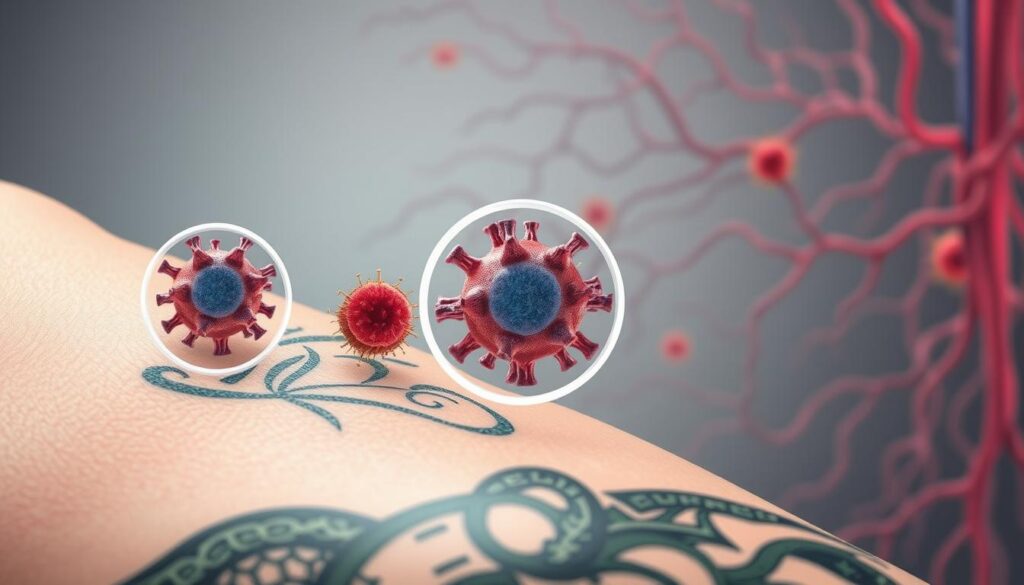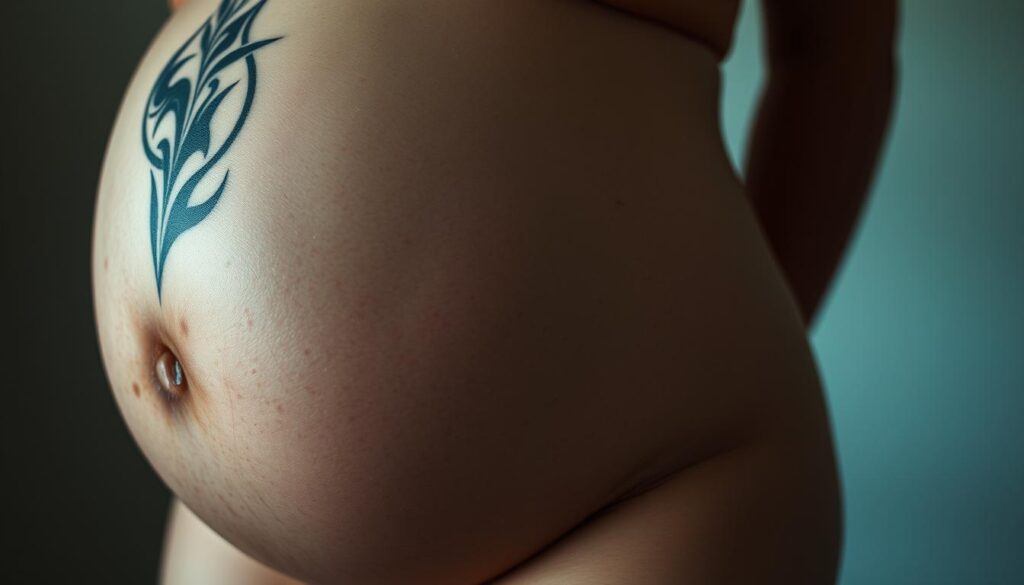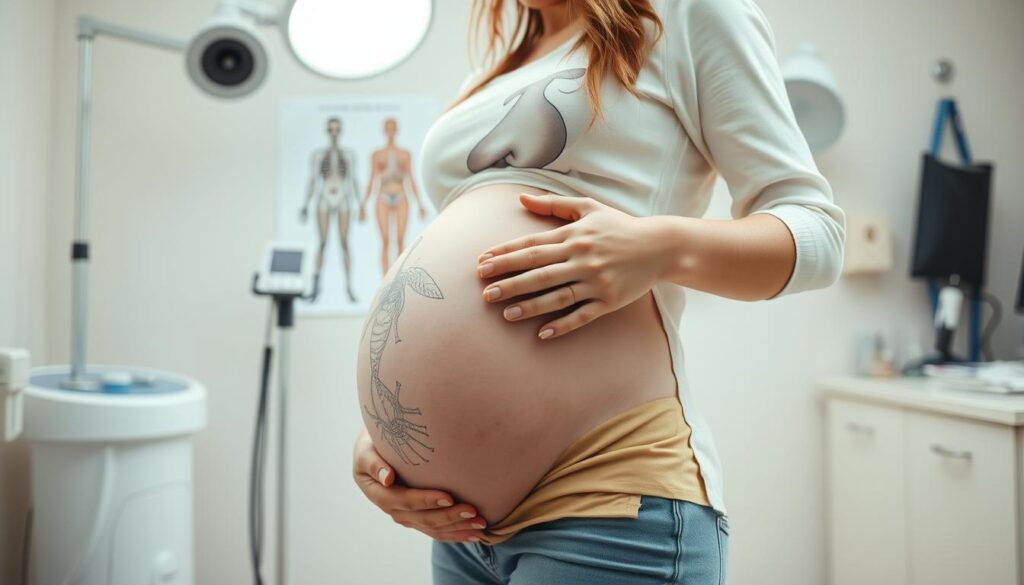
Pregnancy sparks countless questions about what’s safe for you and your baby. Among them: Should body art wait until after delivery? With social media buzzing about creative ways to celebrate motherhood, it’s easy to feel torn between self-expression and caution.
Medical professionals generally recommend postponing body art until after delivery and breastfeeding. Dr. Keely Brown of Overlake Clinics explains, “While studies are limited, the potential risks aren’t worth the gamble.” Your immune system works overtime during these nine months, making infections from tattooing more concerning. Skin sensitivity also increases, which could affect how ink settles or heals.
You’ll find plenty of conflicting advice online, but here’s what matters: Your health and your baby’s well-being come first. We’ve gathered insights from OB-GYNs and dermatologists to help you navigate this decision confidently.
Key Takeaways
- Most experts advise waiting until after pregnancy and breastfeeding for new tattoos
- Immune system changes may increase infection risks during this period
- Skin stretching and sensitivity could impact tattoo appearance
- No conclusive studies exist about specific dangers to developing babies
- Always consult your healthcare provider before making decisions
Understanding Tattooing During Pregnancy

The decision to modify your body during pregnancy involves understanding complex biological interactions. Permanent body art requires needles to deposit ink deep into the dermis – the skin layer housing nerves and blood vessels. This triggers immediate immune responses designed to protect you.
How Needles and Ink Interact With Skin
Electric devices push pigment 1/8 inch beneath the surface during the process. White blood cells rush to isolate foreign particles, but most ink molecules stay trapped permanently. “Your body treats this as an injury,” notes dermatologist Dr. Maria Chen. Stressed systems work harder to manage both healing and fetal development.
Immunity Challenges and Health Risks
Pregnancy naturally lowers defenses to support fetal growth. Reduced infection-fighting capacity raises concerns about contaminated equipment or unsterile environments. Viruses like hepatitis could threaten parent and child more severely during this vulnerable period.
“Even minor bacterial exposure becomes riskier when immunity adapts to nurture a baby,”
Experts emphasize avoiding unnecessary procedures until postpartum recovery. Temporary alternatives like henna allow creative expression without compromising safety.
Body Changes, Skin Sensitivity, and Tattoo Outcomes

Your skin becomes a living canvas of change during these nine months. Hormonal shifts and physical growth create unique conditions that could reshape body art in unexpected ways. What looks perfect today might warp as your baby bump expands.
When Pigment Meets Stretching Skin
Areas like the abdomen and hips undergo dramatic stretching. A floral design inked at 20 weeks might resemble abstract art by 35 weeks. Dr. Lisa Nguyen, a maternal-fetal specialist, notes: “The dermis layer thins by 40% in third-trimester mothers – this directly impacts ink retention.”
Healing Through Hormonal Shifts
Increased blood flow speeds up some processes while slowing others. Your immune system prioritizes fetal development over tattoo aftercare. This dual demand can lead to:
| Body Area | Risk Level | Postpartum Impact |
|---|---|---|
| Stomach | High | Significant stretching |
| Hips | Moderate | Possible distortion |
| Chest | Moderate | Shape changes |
| Lower Back | Low | Minimal impact |
Melasma – those temporary dark patches – might make colors appear muddy. Sensitivity peaks in later trimesters, turning mild discomfort into sharp pain during needle work. Even skilled artists can’t predict how designs will settle on evolving skin.
Post-delivery, some changes reverse within months. Others, like stretch marks, become permanent features. Timing matters – ink applied during rapid growth phases faces the highest distortion risks.
Can You Get a Tattoo While Pregnant? Expert Opinions and Research

The intersection of maternal health and permanent ink draws strong opinions from medical specialists. Leading OB-GYNs and dermatologists agree: limited research exists about pigment deposition during fetal development. This knowledge gap shapes professional guidance for expectant parents.
Medical Community Consensus
Dr. Keely Brown clarifies: “No studies specifically examine tattooing during gestation, but we recommend postponing until postpartum.” This cautious approach stems from understood biological risks rather than direct evidence. Skin-breaking procedures introduce potential pathogens when immunity naturally weakens to support fetal growth.
Board-certified specialist Dr. Layan Alrahmani offers nuanced insight: “Absence of danger proof doesn’t equal safety confirmation.” Healthcare providers emphasize infection prevention over aesthetic desires. Even regulated studios can’t eliminate bloodborne illness risks completely.
Key considerations from experts:
- Uncertain ink effects on placental transfer
- Increased vulnerability to hepatitis/HIV exposure
- Delayed healing from hormonal changes
“Pregnancy demands enough from your body without adding healing stress,” notes Dr. Demosthenes. “Why risk complications for non-essential procedures?”
While miscarriage links remain unproven, doctors universally prioritize caution. Temporary alternatives like semi-permanent ink or henna often satisfy creative urges without comparable risks. Always consult your obstetrician before considering body modifications during this sensitive period.
Tattoo Safety and Best Practices for Pregnant Women

Prioritizing safety becomes non-negotiable when considering body art during this sensitive time. Every choice must balance personal expression with rigorous health protections for you and your baby.
Choosing a Clean, Reputable Tattoo Parlor
Start by vetting studios thoroughly. Check state licensing records and read recent client reviews mentioning cleanliness. Reputable artists often showcase sterilization certifications prominently.
Always disclose your pregnancy when booking. Many professionals refuse clients expecting due to liability concerns. “Ethical artists prioritize client health over profits,” explains ink specialist Mara Torres. If a studio hesitates to answer safety questions, walk away.
Essential safety checks include:
- Autoclave sterilization for all reusable tools
- Single-use needles opened from sealed packages
- Non-toxic inks free from mercury or lead
Watch for red flags like reused stencils or uncovered work surfaces. Proper studios follow strict protocols against bloodborne pathogens. Hepatitis B and HIV remain serious threats if equipment isn’t sanitized correctly.
Even with precautions, remember: No tattoo is risk-free during pregnancy. Discuss plans with your healthcare provider first. Temporary alternatives like plant-based henna offer creative outlets without permanent commitments.
Tattoo Placement and Potential Epidural Concerns
Expectant parents often wonder how body art might affect medical procedures during childbirth. One persistent myth suggests lower back ink could limit pain management options. Let’s separate fact from fiction.
Lower Back Tattoos and Epidural Considerations
Medical research offers reassuring insights. A comprehensive review of 18 years of data found no confirmed complications from epidurals placed near existing back tattoos. Most anesthesiologists prioritize your comfort, working around healed designs when possible.
Fresh ink poses different considerations. If your lower back body art shows redness, swelling, or remains unhealed, providers might avoid that area. These precautions prevent potential infection risks during delivery. Always inform your care team about recent body art.
Planning future tattoos? Discuss placement with both your artist and obstetrician. Strategic positioning allows creative expression while preserving medical flexibility. Remember: well-healed body art rarely impacts epidural access when administered by skilled professionals.
